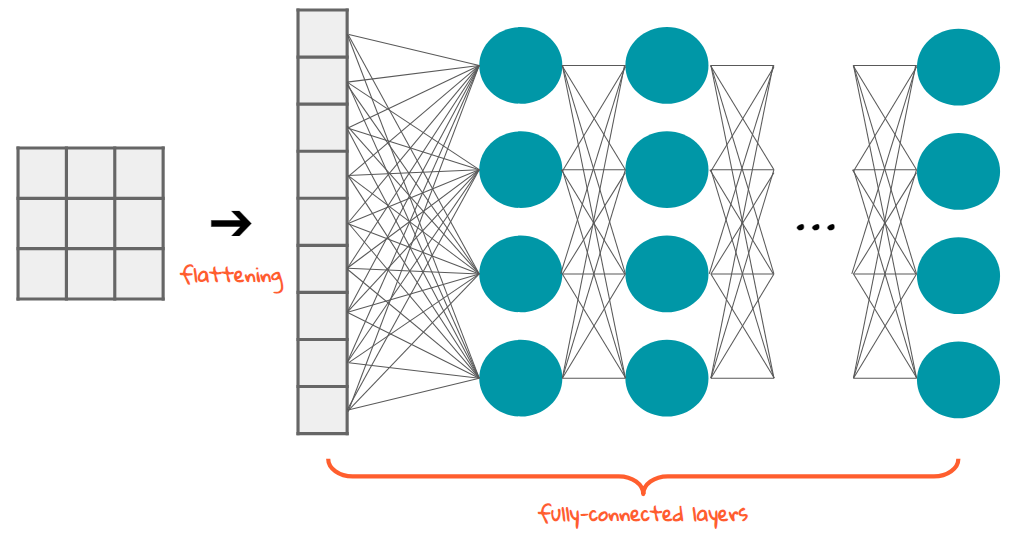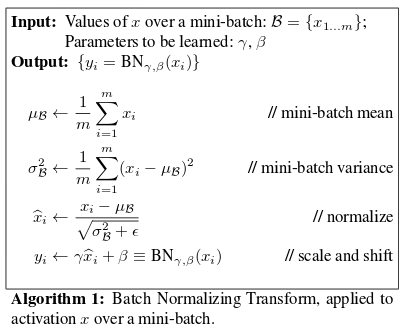GAN keras로 해보기
done
import numpy as np
from tensorflow.keras.utils import to_categorical
from keras.datasets import cifar10
(x_train,y_train),(x_test,y_test)=cifar10.load_data()
데이터 셋을 적재한다.
x_train.shape, x_test.shape, y_train.shape, y_test.shape
- shape에서 첫번째 차원은 index를 가리킴.
- 두 번째 차원은 이미지 높이
- 세 번째 차원은 이미지 너비
- 마지막 차원은 RGB 채널
- 이런 배열을 4차원 tensor라 부름
NUM_CLASSES = 10
x_train = x_train.astype('float32')/255.0
x_test = x_test.astype('float32')/255.0
신경망은 -1~1 사이 놓여있게 만들기!
y_train = to_categorical(y_train,NUM_CLASSES)
y_test = to_categorical(y_test,NUM_CLASSES)
이미지의 정수 레이블을 one-hot-encoding vector로 바꾸기
- 어떤 이미지의 class 정수 레이블이 i라면 이 뜻은 one-hot encoding이 i번빼 원소가 1이고 그외에는 모두 0인 길이가 10(class개수)인 vector가 된다.
- 따라서 shape도 바뀐 것을 볼 수 있음
y_train.shape, y_test.shape
Sequential 모델은 일렬로 층을 쌓은 네트워크를 빠르게 만들때 사용하기 좋음
API 모델은 각각 층으로 볼 수 있음
from tensorflow.keras.models import Sequential
from tensorflow.keras.layers import Flatten, Dense
model = Sequential([Dense(200, activation = 'relu', input_shape=(32,32,3)),
Flatten(),
Dense(150, activation = 'relu'),
Dense(10,activation = 'softmax'),])
Sequential 사용한 network
from tensorflow.keras.layers import Input, Flatten, Dense
from tensorflow.keras.models import Model
input_layer = Input(shape=(32,32,3))
x=Flatten()(input_layer)
x=Dense(units=200,activation='relu')(x)
x=Dense(units=150,activation = 'relu')(x)
output_layer = Dense(units=10,activation='softmax')(x)
model=Model(input_layer,output_layer)
API 사용한 network
model.summary()
-
Input
- 네트워크의 시작점
- 입력 데이터 크기를 튜플에 알려주기
-
Flatten
- 입력을 하나의 vector로 펼치기
- 32 32 3 = 3,072
-
Dense
- 이전 층과 완전하게 연결되는 유닛을 가짐
- 이 층의 각 unit은 이전 층의 모든 unit과 연결됨!
- unit의 출력은 이전 층으로부터 받은 입력과 가중치를 곱하여 더한 것
-
activation function
- 비선형 활성화 함수
- 렐루Relu: 입력이 음수이면 0, 그 외는 입력과 동일한 값 출력
- 리키렐루leaky relu: 음수이면 입력에 비례하는 작은 음수 반환, 그 외는 입력과 동일한 값 출력
- 시그모이드sigmoid: 층의 출력을 0에서 1사이로 조정하고 싶을 때!(binary/multilabel classification에서 사용)
- 소프트맥스softmax: 층의 전체 출력 합이 1이 되어야 할 때 사용(multiclass classification)
- 비선형 활성화 함수



from tensorflow.keras.optimizers import Adam
opt=Adam(lr=0.0001)
model.compile(loss='categorical_crossentropy',optimizer=opt, metrics = ['accuracy'])
손실함수와 옵티마이저 연결
- compile method에 전달
- metrics에 accuracy 같은 기록하고자 하는 지표 지정 가능
model.fit(x_train, # 원본 이미지 데이터
y_train, # one-hot encoding된 class label
batch_size = 32, # 훈련 step마다 network에 전달될 sample 개수 결정
epochs = 10, # network가 전체 훈련 data에 대해 반복하여 훈련할 횟수
shuffle = True) # True면 훈련 step마다 batch를 훈련 data에서 중복 허용않고 random하게 추출
loss는 1.37로 감소했고, accuracy는 51%로 증가했다!
model.evaluate(x_test,y_test)
predic method 사용해서 test 예측결과 확인
CLASSES = np.array(['airplane','automobile','bird','cat','deer','dog','frog','horse','ship','truck'])
preds = model.predict(x_test)
preds.shape
pred_single = CLASSES[np.argmax(preds, axis = -1)]
agrmax로 하나의 예측결과로 바꾸기. axis=-1은 마지막 clss차원으로 배열을 압축하라는 뜻
pred_single.shape
actual_single = CLASSES[np.argmax(y_test,axis=-1)]
actual_single.shape
import matplotlib.pyplot as plt
n_to_show = 10
indices = np.random.choice(range(len(x_test)), n_to_show)
fig=plt.figure(figsize=(15,3))
fig.subplots_adjust(hspace=0.4,wspace=0.5)
for i, idx in enumerate(indices):
img = x_test[idx]
ax=fig.add_subplot(1,n_to_show ,i+1)
ax.axis('off')
ax.text(0.5,-0.35,'pred= ' + str(pred_single[idx]), fontsize=10, ha='center',transform=ax.transAxes)
ax.text(0.5,-0.7,'act= ' + str(actual_single[idx]),fontsize=10, ha='center', transform=ax.transAxes)
ax.imshow(img)
합성곱은 필터를 이미지의 일부분과 픽셀끼리 곱한 후 결과를 더한 것
- 이미지 영역이 필터와 비슷할수록 큰 양수가 출력되고 필터와 반대일수록 큰 음수가 출력됨
-
stride
- 스트라이드는 필터가 한 번에 입력 위를 이동하는 크기,
- stride = 2로 하면 출력 텐서의 높이와 너비는 입력 텐서의 절반이 된다!
- network 통과하면서 채널 수 늘리고, 텐서의 공간 방향 크기 줄이는 데 사용
-
padding
- padding=same은 입력 데이터를 0으로 패딩하여 stride = 1일 때 출력의 크기를 입력 크기와 동일하게 만듦
- padding=same 지정하면 여러 개의 합성곱 층을 통과할 때 텐서의 크기를 쉽게 파악할 수 있는 유용함!
input_layer=Input(shape=(32,32,3))
conv_layer_1 = layers.Conv2D(filters = 10, kernel_size = (4,4), strides = 2, padding = 'same')(input_layer)
conv_layer_2 = layers.Conv2D(filters = 20, kernel_size = (3,3), strides = 2, padding = 'same')(conv_layer_1)
flatten_layer=Flatten()(conv_layer_2)
output_layer=Dense(units=10, activation='softmax')(flatten_layer)
model=Model(input_layer,output_layer)
model.summary()
- gradient exploding 기울기 폭주
- 오차가 네트워크를 통해 거꾸로 전파되면서 앞에 놓인 층의 gradient 계산이 기하급수적으로 증가하는 경우
- covariate shoft 공변량 변화
- 네트워크가 훈련됨에 따라 가중치 값이 랜덤한 초깃값과 멀어지기 때문에 인력 스케일을 조정해도 모든 층의 활성화 울력의 scale이 안정적이지 않을 수 있음
배치정규화
- 배치에 대해 각 입력 채널별로 평균과 표준 편차를 계산한 다음 평균을 빼고 표준편차로 나누어 정규화

이전 층의 unit 일부를 랜덤하게 선택하여 출력을 0으로 지정
- 과대 적합 문제 맊기 가능
input_layer=Input((32,32,3))
x = layers.Conv2D(filters=32, kernel_size=3, strides=1, padding='same')(input_layer)
x=layers.BatchNormalization()(x)
x=layers.LeakyReLU()(x)
x= layers.Conv2D(filters=32, kernel_size=3, strides=2, padding='same')(x)
x=layers.BatchNormalization()(x)
x=layers.LeakyReLU()(x)
x= layers.Conv2D(filters=64, kernel_size=3, strides=1, padding='same')(x)
x=layers.BatchNormalization()(x)
x=layers.LeakyReLU()(x)
x= layers.Conv2D(filters=64, kernel_size=3, strides=2, padding='same')(x)
x=layers.BatchNormalization()(x)
x=layers.LeakyReLU()(x)
x=Flatten()(x)
x=Dense(128)(x)
x=layers.BatchNormalization()(x)
x=layers.LeakyReLU()(x)
x=layers.Dropout(rate=0.5)(x)
x=Dense(NUM_CLASSES)(x)
output_layer = layers.Activation('softmax')(x)
model=Model(input_layer,output_layer)
leakyrelu 층과 batchnomalization 층이 뒤따르는 4개의 conv2d 층을 쌓고 만들어진 텐서를 일렬로 펼쳐 128개의 unit을 가진 dense 층에 통과시키고 다시 한 번 batchnomalization층과 leakyrelu층을 거쳐 dropout층을 지나 10개의 unit을 가진 dense 층이 최종 출력을 만든다.
model.summary()
kernal인 3 곱하기 3 곱하기 3(컬러 rgb 3개) = 27 곱하기 32 = 896
model.compile(loss='categorical_crossentropy',optimizer=opt, metrics = ['accuracy'])
model.fit(x_train, # 원본 이미지 데이터
y_train, # one-hot encoding된 class label
batch_size = 32, # 훈련 step마다 network에 전달될 sample 개수 결정
epochs = 10, # network가 전체 훈련 data에 대해 반복하여 훈련할 횟수
shuffle = True) # True면 훈련 step마다 batch를 훈련 data에서 중복 허용않고 random하게 추출
model.evaluate(x_test,y_test,batch_size=1000)
from tensorflow import keras
from tensorflow.keras import layers
from tensorflow_docs.vis import embed
import matplotlib.pyplot as plt
import tensorflow as tf
import numpy as np
import imageio
batch_size = 64
num_channels = 1
num_classes = 10
image_size = 28
latent_dim = 128
# sets.
(x_train, y_train), (x_test, y_test) = keras.datasets.mnist.load_data()
all_digits = np.concatenate([x_train, x_test])
all_labels = np.concatenate([y_train, y_test])
# Scale the pixel values to [0, 1] range, add a channel dimension to
# the images, and one-hot encode the labels.
all_digits = all_digits.astype("float32") / 255.0
all_digits = np.reshape(all_digits, (-1, 28, 28, 1))
all_labels = keras.utils.to_categorical(all_labels, 10)
# Create tf.data.Dataset.
dataset = tf.data.Dataset.from_tensor_slices((all_digits, all_labels))
dataset = dataset.shuffle(buffer_size=1024).batch(batch_size)
print(f"Shape of training images: {all_digits.shape}")
print(f"Shape of training labels: {all_labels.shape}")
generator_in_channels = latent_dim + num_classes
discriminator_in_channels = num_channels + num_classes
print(generator_in_channels, discriminator_in_channels)
discriminator = keras.Sequential(
[
keras.layers.InputLayer((28, 28, discriminator_in_channels)),
layers.Conv2D(64, (3, 3), strides=(2, 2), padding="same"),
layers.LeakyReLU(alpha=0.2),
layers.Conv2D(128, (3, 3), strides=(2, 2), padding="same"),
layers.LeakyReLU(alpha=0.2),
layers.GlobalMaxPooling2D(),
layers.Dense(1),
],
name="discriminator",
)
# Create the generator.
generator = keras.Sequential(
[
keras.layers.InputLayer((generator_in_channels,)),
# We want to generate 128 + num_classes coefficients to reshape into a
# 7x7x(128 + num_classes) map.
layers.Dense(7 * 7 * generator_in_channels),
layers.LeakyReLU(alpha=0.2),
layers.Reshape((7, 7, generator_in_channels)),
layers.Conv2DTranspose(128, (4, 4), strides=(2, 2), padding="same"),
layers.LeakyReLU(alpha=0.2),
layers.Conv2DTranspose(128, (4, 4), strides=(2, 2), padding="same"),
layers.LeakyReLU(alpha=0.2),
layers.Conv2D(1, (7, 7), padding="same", activation="sigmoid"),
],
name="generator",
)
class ConditionalGAN(keras.Model):
def __init__(self, discriminator, generator, latent_dim):
super(ConditionalGAN, self).__init__()
self.discriminator = discriminator
self.generator = generator
self.latent_dim = latent_dim
self.gen_loss_tracker = keras.metrics.Mean(name="generator_loss")
self.disc_loss_tracker = keras.metrics.Mean(name="discriminator_loss")
@property
def metrics(self):
return [self.gen_loss_tracker, self.disc_loss_tracker]
def compile(self, d_optimizer, g_optimizer, loss_fn):
super(ConditionalGAN, self).compile()
self.d_optimizer = d_optimizer
self.g_optimizer = g_optimizer
self.loss_fn = loss_fn
def train_step(self, data):
# Unpack the data.
real_images, one_hot_labels = data
# Add dummy dimensions to the labels so that they can be concatenated with
# the images. This is for the discriminator.
image_one_hot_labels = one_hot_labels[:, :, None, None]
image_one_hot_labels = tf.repeat(
image_one_hot_labels, repeats=[image_size * image_size]
)
image_one_hot_labels = tf.reshape(
image_one_hot_labels, (-1, image_size, image_size, num_classes)
)
# Sample random points in the latent space and concatenate the labels.
# This is for the generator.
batch_size = tf.shape(real_images)[0]
random_latent_vectors = tf.random.normal(shape=(batch_size, self.latent_dim))
random_vector_labels = tf.concat(
[random_latent_vectors, one_hot_labels], axis=1
)
# Decode the noise (guided by labels) to fake images.
generated_images = self.generator(random_vector_labels)
# Combine them with real images. Note that we are concatenating the labels
# with these images here.
fake_image_and_labels = tf.concat([generated_images, image_one_hot_labels], -1)
real_image_and_labels = tf.concat([real_images, image_one_hot_labels], -1)
combined_images = tf.concat(
[fake_image_and_labels, real_image_and_labels], axis=0
)
# Assemble labels discriminating real from fake images.
labels = tf.concat(
[tf.ones((batch_size, 1)), tf.zeros((batch_size, 1))], axis=0
)
# Train the discriminator.
with tf.GradientTape() as tape:
predictions = self.discriminator(combined_images)
d_loss = self.loss_fn(labels, predictions)
grads = tape.gradient(d_loss, self.discriminator.trainable_weights)
self.d_optimizer.apply_gradients(
zip(grads, self.discriminator.trainable_weights)
)
# Sample random points in the latent space.
random_latent_vectors = tf.random.normal(shape=(batch_size, self.latent_dim))
random_vector_labels = tf.concat(
[random_latent_vectors, one_hot_labels], axis=1
)
# Assemble labels that say "all real images".
misleading_labels = tf.zeros((batch_size, 1))
# Train the generator (note that we should *not* update the weights
# of the discriminator)!
with tf.GradientTape() as tape:
fake_images = self.generator(random_vector_labels)
fake_image_and_labels = tf.concat([fake_images, image_one_hot_labels], -1)
predictions = self.discriminator(fake_image_and_labels)
g_loss = self.loss_fn(misleading_labels, predictions)
grads = tape.gradient(g_loss, self.generator.trainable_weights)
self.g_optimizer.apply_gradients(zip(grads, self.generator.trainable_weights))
# Monitor loss.
self.gen_loss_tracker.update_state(g_loss)
self.disc_loss_tracker.update_state(d_loss)
return {
"g_loss": self.gen_loss_tracker.result(),
"d_loss": self.disc_loss_tracker.result(),
}
cond_gan = ConditionalGAN(
discriminator=discriminator, generator=generator, latent_dim=latent_dim
)
cond_gan.compile(
d_optimizer=keras.optimizers.Adam(learning_rate=0.0003),
g_optimizer=keras.optimizers.Adam(learning_rate=0.0003),
loss_fn=keras.losses.BinaryCrossentropy(from_logits=True),
)
cond_gan.fit(dataset, epochs=5)
trained_gen = cond_gan.generator
# Choose the number of intermediate images that would be generated in
# between the interpolation + 2 (start and last images).
num_interpolation = 9 # @param {type:"integer"}
# Sample noise for the interpolation.
interpolation_noise = tf.random.normal(shape=(1, latent_dim))
interpolation_noise = tf.repeat(interpolation_noise, repeats=num_interpolation)
interpolation_noise = tf.reshape(interpolation_noise, (num_interpolation, latent_dim))
def interpolate_class(first_number, second_number):
# Convert the start and end labels to one-hot encoded vectors.
first_label = keras.utils.to_categorical([first_number], num_classes)
second_label = keras.utils.to_categorical([second_number], num_classes)
first_label = tf.cast(first_label, tf.float32)
second_label = tf.cast(second_label, tf.float32)
# Calculate the interpolation vector between the two labels.
percent_second_label = tf.linspace(0, 1, num_interpolation)[:, None]
percent_second_label = tf.cast(percent_second_label, tf.float32)
interpolation_labels = (
first_label * (1 - percent_second_label) + second_label * percent_second_label
)
# Combine the noise and the labels and run inference with the generator.
noise_and_labels = tf.concat([interpolation_noise, interpolation_labels], 1)
fake = trained_gen.predict(noise_and_labels)
return fake
start_class = 1 # @param {type:"slider", min:0, max:9, step:1}
end_class = 5 # @param {type:"slider", min:0, max:9, step:1}
fake_images = interpolate_class(start_class, end_class)
fake_images *= 255.0
converted_images = fake_images.astype(np.uint8)
converted_images = tf.image.resize(converted_images, (96, 96)).numpy().astype(np.uint8)
imageio.mimsave("animation.gif", converted_images, fps=1)
embed.embed_file("animation.gif")